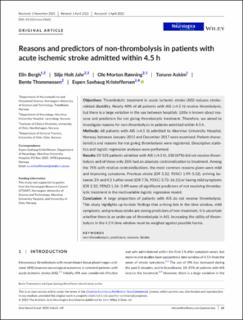| dc.contributor.author | Bergh, Elin | |
| dc.contributor.author | Jahr, Silje Holt | |
| dc.contributor.author | Rønning, Ole Morten | |
| dc.contributor.author | Askim, Torunn | |
| dc.contributor.author | Thommessen, Bente | |
| dc.contributor.author | Kristoffersen, Espen Saxhaug | |
| dc.date.accessioned | 2023-02-09T12:00:52Z | |
| dc.date.available | 2023-02-09T12:00:52Z | |
| dc.date.created | 2022-05-01T13:12:24Z | |
| dc.date.issued | 2022 | |
| dc.identifier.citation | Acta Neurologica Scandinavica. 2022, 146 (1), 61-69. | en_US |
| dc.identifier.issn | 0001-6314 | |
| dc.identifier.uri | https://hdl.handle.net/11250/3049669 | |
| dc.description.abstract | Objectives
Thrombolytic treatment in acute ischemic stroke (AIS) reduces stroke-related disability. Nearly 40% of all patients with AIS (<4.5 h) receive thrombolysis, but there is a large variation in the use between hospitals. Little is known about reasons and predictors for not giving thrombolytic treatment. Therefore, we aimed to investigate reasons for non-thrombolysis in patients admitted within 4.5 h.
Methods
All patients with AIS (<4.5 h) admitted to Akershus University Hospital, Norway, between January 2015 and December 2017 were examined. Patient characteristics and reasons for not giving thrombolysis were registered. Descriptive statistics and logistic regression analyses were performed.
Results
Of 535 patients admitted with AIS (<4.5 h), 250 (47%) did not receive thrombolysis and of these only 26% had an absolute contraindication to treatment. Among the 74% with relative contraindications, the most common reasons given were mild and improving symptoms. Previous stroke (OR 3.32, 95%CI 1.99–5.52), arriving between 3 h and 4.5 h after onset (OR 7.76, 95%CI 3.73–16.11) or having mild symptoms (OR 2.33, 95%CI 1.56–3.49) were all significant predictors of not receiving thrombolytic treatment in the multivariable logistic regression model.
Conclusion
A large proportion of patients with AIS do not receive thrombolysis. This study highlights up-to-date findings that arriving late in the time window, mild symptoms, and previous stroke are strong predictors of non-treatment. It is uncertain whether there is an underuse of thrombolysis in AIS. Increasing the utility of thrombolysis in the 4.5 h time window must be weighed against possible harms. | en_US |
| dc.language.iso | eng | en_US |
| dc.publisher | John Wiley & Sons | en_US |
| dc.rights | Navngivelse-Ikkekommersiell 4.0 Internasjonal | * |
| dc.rights.uri | http://creativecommons.org/licenses/by-nc/4.0/deed.no | * |
| dc.title | Reasons and predictors of non-thrombolysis in patients with acute ischemic stroke admitted within 4.5 h | en_US |
| dc.title.alternative | Reasons and predictors of non-thrombolysis in patients with acute ischemic stroke admitted within 4.5 h | en_US |
| dc.type | Peer reviewed | en_US |
| dc.type | Journal article | en_US |
| dc.description.version | publishedVersion | en_US |
| dc.source.pagenumber | 61-69 | en_US |
| dc.source.volume | 146 | en_US |
| dc.source.journal | Acta Neurologica Scandinavica | en_US |
| dc.source.issue | 1 | en_US |
| dc.identifier.doi | 10.1111/ane.13622 | |
| dc.identifier.cristin | 2020397 | |
| cristin.ispublished | true | |
| cristin.fulltext | original | |
| cristin.qualitycode | 1 | |

